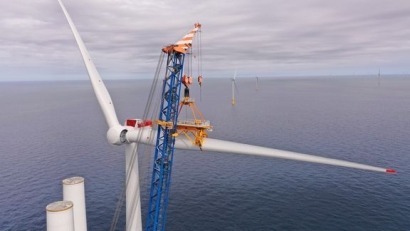
The developers design, build, and operate offshore wind farms globally, including Europe, North America, and Asia. They will work in collaboration with the Carbon Trust as part of the new Offshore Wind Sustainability Joint Industry Program to develop the first industry-backed methodology and guidance to measure and address the carbon emissions associated with offshore wind farms throughout their life cycle, including emissions from the manufacturing of materials and installation of wind farms.
The aim of this work is to help the global offshore wind industry scale as sustainably as possible and continue its important contribution towards meeting the world's net-zero target by 2050 and limiting the most extreme impacts of climate change. A common standard will ensure that the scale of installation needed is delivered in a low-carbon way and encourage comparability across developers and assets.
Jan Matthiesen, Director, Offshore Wind at the Carbon Trust, said, "Global climate targets can't be met without stepping up renewable energy generation, and offshore wind is particularly crucial to the world's transition away from fossil fuels.
"Our experience working with the industry through various joint industry projects is proof that collaboration is key. Over the last 14 years, we've focused on scaling up the offshore wind market through our joint industry programmes such as the Offshore Wind Accelerator and the Floating Wind Joint Industry Program."
He adds, "Now it's time to turn our attention to supporting innovation and scaling up sustainably to create a more resilient and competitive industry. We're delighted to be collaborating with such a global set of developers, whose collective voice has the potential to take the industry to the next level."
Ingrid Reumert, Senior Vice President and Head of Global Stakeholder Relations at Ørsted, said, "Energy still accounts for 73 % of global emissions, which makes a fast transition from fossil fuels to renewables the single most important climate action.
"As our industry prepares for a massive and necessary buildout of offshore wind farms, we must also pay attention to driving down emissions from supply chains and operations. This common methodology will help us do that as well as increasing transparency for governments, investors, and suppliers and enabling comparability across developers and assets."
By the end of 2021, 55 GW of offshore wind capacity had been installed globally, with over a third being installed within 2021. However, according to the IEA, an additional 70-80 GW will need to be installed every year from 2030 in order to achieve net-zero by 2050.
As demand for renewable energy grows, the offshore wind industry needs to scale up rapidly to meet this level of ambition, and this must be done in a sustainable way. Building on the decarbonization efforts at an individual wind farm level, a collaborative industry effort will be key to creating a consistent approach to account for carbon impacts, increase transparency of supply chain emissions, and accelerate engagement across the value chain.
This will support the delivery of the scale of installation needed, with the benefit of a strong understanding of lifecycle carbon emissions.
While offshore wind energy generation has a significantly lower carbon impact than fossil fuels, the sector must also work collaboratively to decouple its own value chain from carbon and resource-intensive models of production, deployment, and operation, addressing key hotspots such as steel, cement, and fuels.
The first project delivered as part of the Offshore Wind Sustainability Joint Industry Program will:
The program officially kicked off in January 2023, with the methodology expected to be released for use across the industry by 2025.
This program is the fifth addition to the Carbon Trust's renewable energy innovation platform, which consists of a portfolio of R&D activities such as the Offshore Wind Accelerator (OWA), the Floating Wind Joint Industry Program,the Integrator, and the Offshore Renewables Joint Industry Program.

